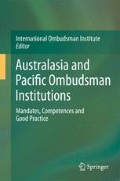Abstract
New South Wales is one of six states of the Commonwealth of Australia. Australia has a federal system of government with legislative powers distributed between the Federal Government (Commonwealth) and the states (with exclusive and concurrent powers). The legal system is based on English Common Law.
Access this chapter
Tax calculation will be finalised at checkout
Purchases are for personal use only
Notes
- 1.
Cf Sect. 7, p. 101 for more information on the Commonwealth.
- 2.
Cf Sect. 7, p. 101 for more information on the Commonwealth legal system.
- 3.
Australian Bureau of Statistics (June 2011).
- 4.
- 5.
Cf www.Parliament.nsw.gov.au/prod/web/common.nsf/key/ResourcesSystemCourtsTheJudiciary for more information on the judicial system.
- 6.
Cf www.fairwork.gov.au/ for details.
- 7.
The office is “part of the legislative portfolio of the Premier”. However, the Premier does not take any “direct role in relation to [the office’s] work”. Cf APOR Manual (2009), p. 9.
- 8.
S6(6) OA stipulates that the Public Sector Management Act 1988 does not apply to the Ombudsman.
- 9.
Agencies are encouraged to install policies in connection to the employment of women, of people with disabilities and of Aboriginal people.
- 10.
Cf s6(9) OA.
- 11.
Established pursuant to the Statutory and Other Offices Remuneration Act 1975.
- 12.
According to information provided by the office, the remuneration is higher than that of the Chief Justice of the Supreme Court of New South Wales.
- 13.
In the 2010–2011 reporting period, Ombudsman staff visited 59 regional centres and remote communities in New South Wales.
- 14.
Cf Appropriation Act (NSW) for details.
- 15.
The Public Finance and Audit Act 1983 and relevant procurement policies apply to all financial decisions.
- 16.
Cf Annual Report 2010/2011, p. 119.
- 17.
Children Legislation Amendment (Wood Inquiry Recommendations) Act 2009.
- 18.
Cf Annual Report 2010/2011, p. 2.
- 19.
Cf s19ZE(1) Ombudsman Act (Commonwealth).
- 20.
Cf www.tio.com.au/ for details.
- 21.
Cf www.phio.org.au/ for details.
- 22.
Cf www.ewon.com.au for details.
- 23.
Cf www.fos.org.au/centric/home_page.jsp for details.
- 24.
Cf www.hccc.nsw.gov.au/ for details.
- 25.
However, the exercise of civic rights such as a whistle-blower disclosure by an employee may be investigated.
- 26.
Schedule 1 of the OA contains the full list of excluded bodies. For ease of reference, cf also www.ombo.nsw.gov.au/complaints/whatcantcomplainabt.html.
- 27.
Cf s4(1) Government Information (Public Access) Act. For details on the new office see also Government Information (Information Commissioner) Act 2009.
- 28.
Between 1989 and 2010, the office’s responsibilities fell under the Freedom of Information Act 1989. With the introduction of the Government Information (Public Access) Act 2009 this responsibility has been placed with the newly formed Information Commissioner.
- 29.
In the 2010–2011 reporting period, the New South Wales Ombudsman finalised 35 direct investigations.
- 30.
Implementation figures show that in the 2010–2011 reporting period, approximately 80 % of the recommendations made in investigations reports were implemented.
- 31.
The latter is only possible if the public authority is employed under the Public Sector Management Act 1988.
- 32.
The Ombudsman, in his or her function as the Community and Disability Services Commissioner, has the task of monitoring, reviewing and investigating complaints in regard to the delivery of community services.
- 33.
Under the PA, the Ombudsman has, among others, the task of auditing complaint mechanisms to make sure the Police handle a complaint effectively and fairly.
- 34.
Established under Part 7A of the Commission for Children and Young People Act 1998.
- 35.
Cf www.ombo.nsw.gov.au/aboutus/reviewimplemlegislatn.html for details.
- 36.
Cf www.ombo.nsw.gov.au/aboutus/legislation.html for details.
- 37.
In practice, however, this is rarely done.
- 38.
Information provided by the Institution.
- 39.
Justice health provides health care services for those in contact with the criminal justice system, cf www.justicehealth.nsw.gov.au/ for details.
- 40.
Cf Annual Report 2010/2011, p. 9.
- 41.
Cf Annual Report 2010/2011, p. 30.
- 42.
Information provided by the Institution.
- 43.
Cf www.ombo.nsw.gov.au/publication/index.html for a comprehensive list.
- 44.
Cf Annual Report 2009/2010, p. 3, and the Ombudsman Amendment (Removal of Legal Professional Privilege) Act 2010.
Reference
Commonwealth Ombudsman (2009a) Australasia and Pacific Ombudsman Region Information Manual 2009. Commonwealth Ombudsman, Canberra. www.ombudsman.gov.au/docs/APOR-Manual_20091009.pdf. Accessed 10 Nov 2011
Further Reading
Overview of Legislation: www.ombo.nsw.gov.au/aboutus/legislation.html
Constitution: www.legislation.nsw.gov.au/viewtop/inforce/act+32+1902+FIRST+0+N/
Annual Reports: www.ombo.nsw.gov.au/publication/annualreports.asp
Author information
Authors and Affiliations
Corresponding author
Editor information
Editors and Affiliations
Rights and permissions
Copyright information
© 2013 Springer-Verlag Berlin Heidelberg
About this chapter
Cite this chapter
Frahm, M. (2013). Australia: Ombudsman New South Wales. In: Australasia and Pacific Ombudsman Institutions. Springer, Berlin, Heidelberg. https://doi.org/10.1007/978-3-642-33896-0_8
Download citation
DOI: https://doi.org/10.1007/978-3-642-33896-0_8
Published:
Publisher Name: Springer, Berlin, Heidelberg
Print ISBN: 978-3-642-33895-3
Online ISBN: 978-3-642-33896-0
eBook Packages: Humanities, Social Sciences and LawLaw and Criminology (R0)

